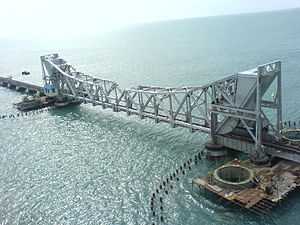Pamban Bridge
| Pamban Bridge பாம்பன் பாலம் | |
|---|---|
 Pamban Road and Rail Bridge | |
| Official name | Annai Indira Gandhi Bridge |
| Carries | 2 lanes of road traffic |
| Crosses | Palk Strait |
| Locale | Rameswaram, Tamil Nadu, India |
| Coordinates | 9°16′57.25″N 79°12′5.91″E / 9.2825694°N 79.2016417°ECoordinates: 9°16′57.25″N 79°12′5.91″E / 9.2825694°N 79.2016417°E |
The Pamban Bridge is a cantilever bridge on the Palk Strait which connects the town of Rameswaram on Pamban Island to mainland India. The bridge refers to both the road bridge and the cantilever railway bridge, though primarily it means the latter. Opened in 1914, it was India's first sea bridge, and was the longest sea bridge in India till 2010. The rail bridge is for the most part, a conventional bridge resting on concrete piers, but has a double leaf bascule section midway, which can be raised to let ships and barges pass through.
History
The railway bridge is 6,776 ft (2,065 m) and was opened for traffic in 1914.[1] The railroad bridge is a still-functioning double-leaf bascule bridge section that can be raised to let ships pass under the bridge.
The railway bridge historically carried metre-gauge trains on it, but Indian Railways upgraded the bridge to carry broad-gauge trains in a project that finished Aug. 12, 2007. Until recently, the two leaves of the bridge were opened manually using levers by workers.[1] About 10 ships — cargo carriers, coast guard ships, fishing vessels and oil tankers — pass through the bridge every month. From the elevated two-lane road bridge, adjoining islands and the parallel rail bridge below can be viewed.


After completion of bridge metre-gauge lines were laid by them from Mandapam up to Pamban Station, from here the railway lines bifurcated into two directions one towards Rameshwaram about 6.25 miles (10.06 km) up and another branch line of 15 miles (24 km) terminating at Dhanushkodi. The section was opened to traffic in 1914.[2][3]
The noted boat mail ran on this track between 1915 and 1964 from Madras-Egmore up to Dhanushkodi, from where the passengers were ferried to Talaimannar in Ceylon. The metre-gauge branch line from Pamban Junction to Dhanushkodi was abandoned after it was destroyed in a cyclone in 1964.[4]
The bridge was subsequently restored to working conditions under E. Sreedharan in just 46 days.[5]
On 13 January 2013 the bridge suffered minor damages when a naval barge that went adrift close to the Pamban Rail Bridge collided with the century old structure that's vying for UNESCO's heritage status. The ship that was towing a naval barge from Kolkata to a port near Mumbai first went aground hitting rocks on the January 10 following bad weather. Disaster followed as the vessel remained stuck just 50 metres away from the rail bridge. The barge that was afloat around 100 metres away hit the Pamban Rail Bridge.

Location
The bridge spans a 2 km-strait between mainland and island and is the only surface transport link between the two. The mainland end of the bridge is located at 9°16′56.70″N 79°11′20.12″E / 9.2824167°N 79.1889222°E.

According to Dr Narayanan, the bridge is located at the "world's second highly corrosive environment", next to Miami, US, making the construction a challenging job. The location is also a cyclone-prone high wind velocity zone.[1] This Bridge consist of 143 piers and the centre span is a Schrezers rolling type lift span. It's 220 ft (67 m) long and each of 100 tonnes.
Rumours about the Bridge
There are rumours floating around regarding a worker letting his son die while operating on the bridge so that a train passes through safely.[6] But these are probably false as the bridge requires twelve people, six on each side, to manually operate its moving sections.[7] Also, there is no such picture at the entrance of the bridge. And neither is this story known to locals as fact or hearsay from previous generations. The story seems to have been entirely manufactured on the internet.
See also
- Bandra-Worli Sea Link
- List of longest bridges in the world
- List of longest bridges above water in India
References
| Wikimedia Commons has media related to Pamban Bridge. |
- ↑ 1.0 1.1 1.2 Raja Simhan T.E. (21 November 2013). "Pamban Bridge to be pulled down for gauge conversion". The Hindu. Retrieved 17 January 2014.
- ↑ Nanji Bapa ni Nondh-pothi published in Gujarati in year 1999 from Vadodara.It is a diary of Railway Contracts done by Mistris of Kutch noted by Nanji Govindji Tank of Jamshedpur, complied by Dharsibhai Jethalal Tank. (This book was given Aank Sidhhi award by Kutch Shakti at Mumbai in year 2000.) Pamban Bridge Contractors: Built by Manji Daya Vegad & Lakhu Devji Vegad of Anjar & Gangji Narayan of Khedoi started works in 1887 for South Indian Railway. Also built Neel-Mandir at Rameshwaram : Page :29
- ↑ Shree Kutch Gurjar Kshatriya Samaj : A brief History & Glory of our fore-fathers :by Raja Pawan Jethwa. (2007). Section II: Mileage wise available Details of Railway lines laid.Pages:63 to 70
- ↑ Their sentiment to metre gauge train is unfathomable
- ↑ http://www.forbes.com/global/2009/0511/026-india-delhi-subway-builder.html
- ↑ "Extra Extra !!!: A father's sacrifice - True Story". 26 March 2008. Retrieved 2 July 2012.
- ↑ "Bridge of memories - and to Rameswaram - reopens". Hindustan Times. 11 August 2007.
External links
- Barge cross Pamban rail bridge
- Strengthening of Pamban Railway Bridge
- Ship collides into century-old rail bridge